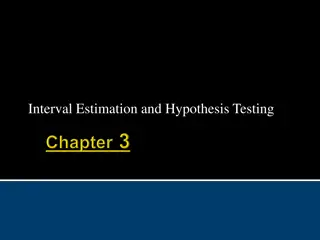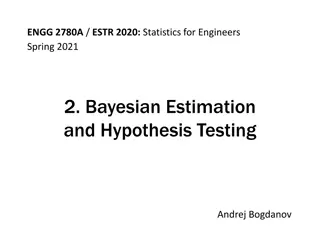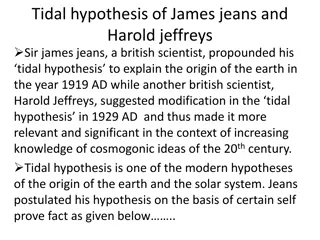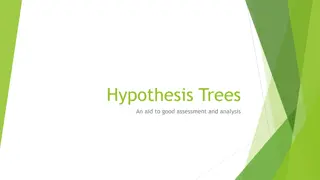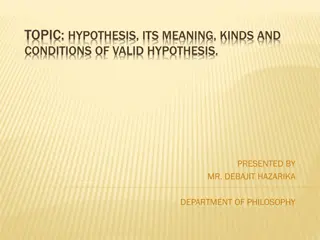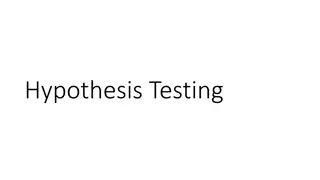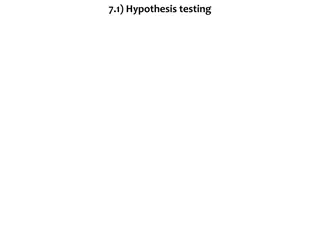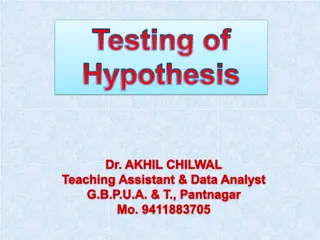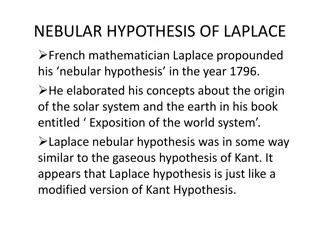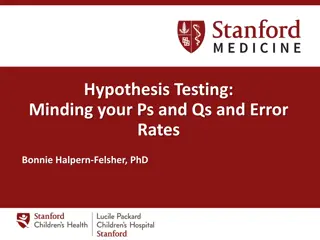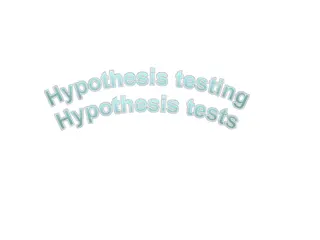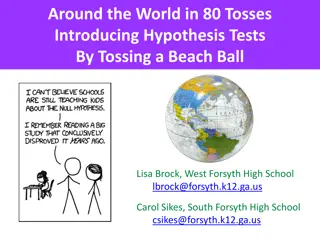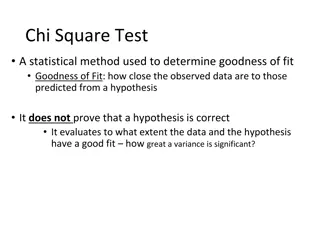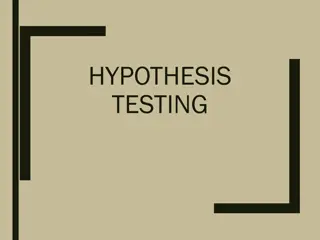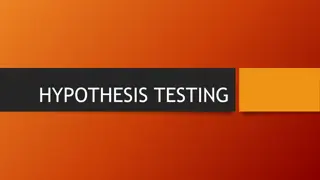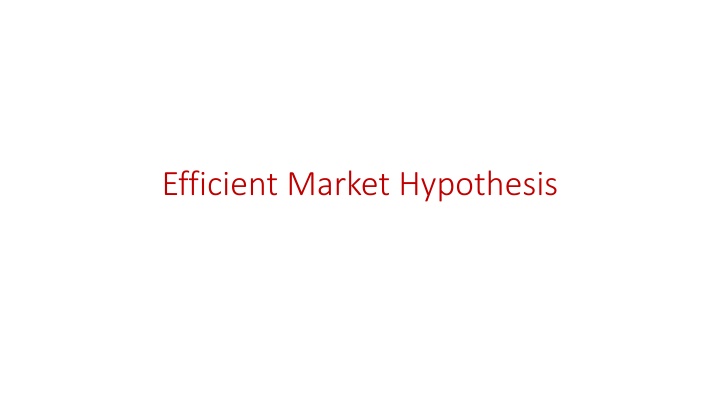
Understanding the Efficient Market Hypothesis and Random Walk Theory
Explore how stock prices are influenced by various factors such as fundamental, technical, and psychological elements. Delve into the debate between the Efficient Market Hypothesis and the Random Walk Theory regarding the predictability of stock price movements based on available information.
Download Presentation

Please find below an Image/Link to download the presentation.
The content on the website is provided AS IS for your information and personal use only. It may not be sold, licensed, or shared on other websites without obtaining consent from the author. If you encounter any issues during the download, it is possible that the publisher has removed the file from their server.
You are allowed to download the files provided on this website for personal or commercial use, subject to the condition that they are used lawfully. All files are the property of their respective owners.
The content on the website is provided AS IS for your information and personal use only. It may not be sold, licensed, or shared on other websites without obtaining consent from the author.
E N D
Presentation Transcript
Introduction Stock prices are determined by a number of factors such as fundamental factors, technical factors and psychological factors. The behavior of stock prices is studied with the help of different methods such as fundamental analysis and technical analysis. Fundamental analysis seeks to evaluate the intrinsic value of securities by studying the fundamental factors affecting the performance of the economy, industry and companies. Technical analysis believes that the past behavior of stock prices gives an indication of the future behavior. It tries to study the patterns in stock price behavior through charts and predict the future movement in prices.
Introduction The basic assumption in technical analysis is that stock pie movement is quite orderly and not random. The new theory questions this assumption. From the results of several empirical studies on stock price movements, the advocates of the new theory assert that share price movements are random. The new theory came to be known as Random Walk Theory because of its principal contention that share price movements represent a random walk rather than an orderly movement.
Random Walk Theory A change occurs in the price of a stock only because of certain changes in the economy, industry or company. Information about these changes alters the stock prices immediately and the stock moves to a new level, either upwards or downwards, depending on the type of information. This rapid shift to a new equilibrium level whenever new information is received is recognition of the fact that all information which is known is fully reflected in the price of the stock. Further change in the price of the stock will occur only as a result of some other new piece of information which was not available earlier. Thus, according to this theory, changes in stock prices show independent behavior and are dependent on the new pieces of information that are received but within themselves are independent of each other. Each price change is independent of other price changes because each change is caused by a new piece of information
Random Walk Theory The basic premise in random walk theory is that the information on changes in the economy, industry and company performance is immediately and fully spread so that all investors have full knowledge of the information. There is an instant adjustment in stock prices either upwards or downwards. Thus, the current stock price fully reflects all available information on the stock. Therefore, the price of a security two days ago can in no way help in speculating the price two days later. The price of each day is independent. It maybe unchanged, higher or lower from the previous price, but that depends on new pieces of information being received each day.
Random Walk Theory The random walk theory presupposes that the stock markets are so efficient and competitive that there is immediate price adjustment. This is the result of good communication system through which information can be spread almost anywhere in the country instantaneously. Thus, the random walk theory is based on the hypothesis that the stock markets are efficient. Hence, this theory later came to be known as the efficient market hypothesis (EMH) or the efficient market model.
The Efficient Market Hypothesis This hypothesis states that the capital market is efficient in processing information. An efficient capital market is one in which security prices equal their intrinsic values at all times, and where most securities are correctly priced. Efficient capital markets mean that security prices fully reflect all available information . The prices of securities observed at any time are based on correct evaluation of all information available at that time.
The Efficient Market Hypothesis The efficient market model is actually concerned with the speed with which information is incorporated into security prices. The technicians believe that past price sequence contains information about the future price movements because they believe that information is slowly incorporated in security prices. This gives technicians an opportunity to earn excess returns by studying the patterns in price movements and trading accordingly
The Efficient Market Hypothesis Fundamentalists believe that it may take several days or weeks before investors can fully assess the impact of new information. As a consequence, the price may be volatile for a number of days before it adjusts to a new level. This provides an opportunity to the analyst who has superior analytical skills to earn excess returns.
The Efficient Market Hypothesis The efficient market theory holds the view that in an efficient market, new information is processed and evaluated as it arrives and prices instantaneously adjust to new and correct levels. Consequently, an investor cannot consistently earn excess returns by undertaking fundamental analysis or technical analysis.
Forms of Market Efficiency The capital market is considered to be efficient in three different forms: The weak form Semi-strong form and The strong form
Weak-Form Efficient Market Hypothesis The weak-form EMH assumes that current stock prices fully reflect all security market information, including the historical sequence of prices, rates of return, trading volume data, and other market-generated transactions by market makers. information and
Weak-Form Efficient Market Hypothesis Because it assumes that current market prices already reflect all past returns and any other security market information, this hypothesis implies that past rates of return and other historical market data should have no relationship with future rates of return.
Semistrong-Form Efficient Market Hypothesis The semistrong-form EMH asserts that security prices adjust rapidly to the release of all public information; that is, current security prices fully reflect all public information. The semi strong hypothesis encompasses hypothesis, because all the market information considered by the weak-form hypothesis, such as stock prices, rates of return, and trading volume, is public. the weak-form
Semistrong-Form Efficient Market Hypothesis Public information also includes all nonmarket information, such as earnings and dividend announcements, price-to- earnings (P/E) ratios, dividend-yield (D/P) ratios, price-book value (P/BV) ratios, stock splits, news about the economy etc
Strong-Form Efficient Market Hypothesis The strong-form EMH contends that stock prices fully reflect all information from public and private sources. This means that no group of investors has monopolistic access to information relevant to the formation of prices. Therefore, this hypothesis contends that no group of investors should be able to consistently derive above- average risk-adjusted rates of return.
Strong-Form Efficient Market Hypothesis The strong-form EMH encompasses both the weak-form and the semistrong-form EMH. Further, the strong-form EMH extends the assumption of efficient markets, in which prices adjust rapidly to the release of new public information, to assume perfect markets, in which all information is cost-free and available to everyone at the same time.
Forms of Market Efficiency The different forms of efficient market hypothesis have been tested through several empirical studies. The tests of the weak form hypothesis are essentially tests of whether all information contained in historical prices of securities is fully reflected in current prices. Semi-strong form tests of the efficient market hypothesis are tests of whether publicly available information is fully reflected in current stock prices. Finally, strong form tests of the efficient market hypothesis are tests of whether all information, both public and private (or inside), is fully reflected in security prices and whether any type of investor is able to earn excess returns.
Empirical Tests of Weak Form Efficiency The weak form of the efficient market hypothesis (EMH) says that the current prices of stocks already fully reflect all the information that is contained in the historical sequence of prices. The new price movements are completely random. They are produced by new pieces of information and are not related or dependent on past price movements. Therefore, there is no benefit in studying the historical sequence of prices to gain abnormal returns from trading in securities. This implies that technical analysis, which relies on charts of price movements in the past, is not a meaningful analysis for making abnormal trading profits.
Empirical Tests of Weak Form Efficiency The weak form of the efficient market hypothesis is thus a direct repudiation of technical analysis.
Empirical Tests of Weak Form Efficiency Two approaches have been used to test the weak form of the efficient market hypothesis. One approach looks for statistically significant patterns in security price changes. The alternative approach searches for profitable short-term trading rules.
Serial Correlation Test Since the weak form EMH postulates independence between successive price changes, such independence or randomness in stock price movements can be tested by calculating the correlation between price changes in one period and changes for the same stock in another period. The correlation coefficient can take on a value ranging from 1 to 1; a positive number indicates a direct relation, a negative value implies an inverse relationship and a value close to zero implies no relationship. Thus, if correlation coefficient is close to zero, the price changes can be considered to be serially independent.
Run Test The run test is another test used to test the randomness in stock price movements. In this test, the absolute values of price changes are ignored; only the direction of change is considered. An increase in price is represented by + signs. The decrease is represented by sign. When there is no change in prices, it is represented by O . A consecutive sequence of the same sign is considered as a run.
Run Test For example, the sequence + + + has two runs. In other words, a change of sign indicates a new run. The sequence + + 0 + + + + has five runs; a run of three s, followed by a run of two + s, another run of one 0, a fourth run of three s and a fifth run of four + s. In a run test, the actual number of runs observed in a series of stock price movements is compared with the number of runs in a randomly generated number series. If no significant differences are found, then the security price changes are considered to be random in nature.
Empirical Tests of Semi-Strong Form Efficiency The semi-strong form of the efficient market hypothesis says that current prices of stocks not only reflect all informational content of historical prices, but also reflect all publicly available information about the company being studied. Examples of publicly available information are corporate annual reports, company announcements, press releases, announcements of forthcoming dividends, stock splits, etc. The semi-strong hypothesis maintains that as soon as the information becomes public the stock prices change and absorb the full information. In other words, stock prices instantaneously adjust to the information that is received.
Empirical Tests of Semi-Strong Form Efficiency The fundamental analysts cannot make superior gains by undertaking fundamental analysis because stock prices adjust to new pieces of information as soon as they are received. There is no time gap in which a fundamental analyst can trade for superior gains. Thus, the semi-strong hypothesis repudiates fundamental analysis. implication of semi-strong hypothesis is that
Empirical Tests of Semi-Strong Form Efficiency Semi-strong form tests deal with whether or not security prices fully reflect all publicly available information. These tests attempt to establish whether share prices react precisely and quickly to new items of information. If prices do not react quickly and adequately, then an opportunity exists for investors or analysts to earn excess returns by using this information. Therefore, these tests also attempt to find if analysts are able to earn superior returns by using publicly available information.
Empirical Tests of Semi-Strong Form Efficiency There is an enormous amount and variety of public information. Semi-strong form tests have been performed with respect to many different types of information. Much of the methodology used in semi-strong form tests has been introduced by Fama, Fisher, Jensen and Roll. Theirs was the first of the studies that were directly concerned with the testing of the semi- strong form of EMH.
Empirical Tests of Semi-Strong Form Efficiency The general methodology followed in these studies has been to take an economic event and measure its impact on the share price. The impact is measured by taking the difference between the actual return and expected return on a security. The expected return on a security is generally estimated by using the market model (or single index model) suggested by William Sharpe. The model used for estimating expected returns is the following: Ri = ai + bi Rm + ei Where Ri = Return on security i. Rm = Return on a market index. ai & bi = Constants. ei = Random error
Empirical Tests of Semi-Strong Form Efficiency This analysis is known as Residual analysis. The positive difference between the actual return and the expected return represents the excess return earned on a security. If the excess return is close to zero, it implies that the price reaction following the public announcement of information is immediate and the price adjusts to a new level almost immediately. Thus, the lack of excess returns would validate the semi-strong form EMH
Empirical Tests of Semi-Strong Form Efficiency Major studies on the impact of capitalization issues such as stock splits and stock dividends have been conducted in the United States by Fama, Fisher, Jensen and Roll and Johnson. Studies found that the market adjusted share prices instantaneously and accurately for the new information. Both Pettit and Watts have investigated the market s reaction to dividend announcements. They both found that all the price adjustment was announcement and thus, the market had acted quickly in evaluating the information. over immediately after the
Empirical Tests of Semi-Strong Form Efficiency Other items of information whose impact on share prices have been tested include announcements of purchase and sale of large blocks of shares of a company, takeovers, annual earnings of companies, quarterly earnings, accounting procedure changes, and earnings estimates made by company officials. All these studies which made use of the Residual analysis approach, showed the market to be relatively efficient.
Empirical Tests of Semi-Strong Form Efficiency Ball and Brown tested the stock market s ability to absorb the informational content of reported annual earnings per share information. They found that companies with good earnings report experienced price increase in stock, while companies with bad earnings report experienced decline in stock prices. But surprisingly, about 85 per cent of the informational content of the earnings announcements was reflected in stock price movements prior to the release of the actual earnings figure. The market seems to adjust to new information rapidly with much of the impact taking place in anticipation of the announcement
Empirical Tests of Semi-Strong Form Efficiency Joy, Litzenberger and McEnally tested the impact of quarterly earnings announcements on the stock price adjustment mechanism and found that the favorable information contained in published quarterly earnings reports was not always instantaneously adjusted in stock prices. This may suggest that the market does not adjust share prices equally well for all types of information. By way of summary it may be stated that a great majority of the semi- strong efficiency tests provide strong empirical support for the hypothesis; however, there have been some contradictory results too. Most of the reported results show that stock announcements of new information and that investors are typically unable to utilize this information to earn consistently above average returns prices do adjust rapidly to
Tests of Strong Form Efficiency The strong form hypothesis represents the extreme case of market efficiency. The strong form of the efficient market hypothesis maintains that the current security prices reflect all information both publicly available information as well as private or inside information. This implies that no information, whether public or inside, can be used to earn superior returns consistently. The directors of companies and other persons occupying senior management positions within companies have access to much information that is not available to the general public. This is known as inside information. Mutual funds and other professional analysts who have large research facilities may gather much private information regarding different stocks on their own. These are private information not available to the investing public at large.
Tests of Strong Form Efficiency The strong form efficiency tests involve two types of tests. The first type of tests attempt to find whether those who have access to inside information have been able to utilize profitably such inside information to earn excess returns. The second type of tests examine the performance of mutual funds and the recommendations of investment analysts to see if these have succeeded in achieving superior returns with the use of private information generated by them.
Tests of Strong Form Efficiency Jaffe, Lorie and Niederhoffer studied the profitability of insider trading (i.e. the investment activities of people who had inside information on companies). They found that insiders earned returns in excess of expected returns. These results indicate that markets are probably not efficient in the strong form.
Tests of Strong Form Efficiency The results of research on strong form EMH may be summarized as follows: 1. Inside information can be used to earn above average returns. 2. Mutual funds and investment analysts have not been able to earn superior returns by using their private information. In conclusion, it may be stated that the strong form hypothesis is invalid as regards inside information, but valid as regards private information other than inside information
Conclusion The evidence on the EMH is mixed. Some studies have supported the hypotheses and indicate that capital markets are efficient. Results of other studies have revealed some anomalies related to these hypotheses, indicating results that do not support the hypotheses.

